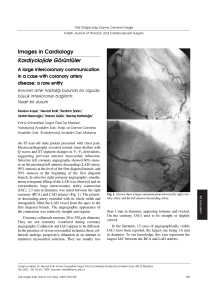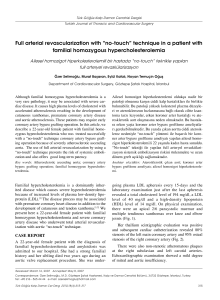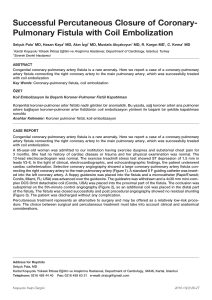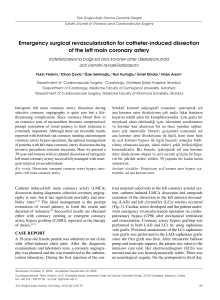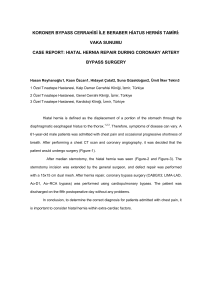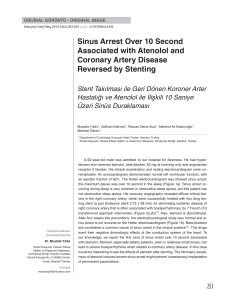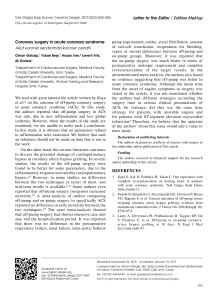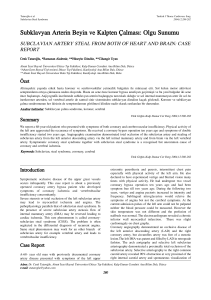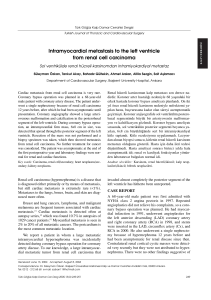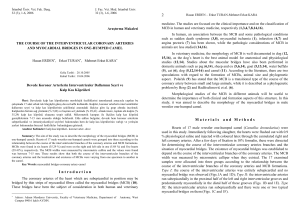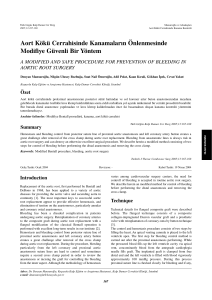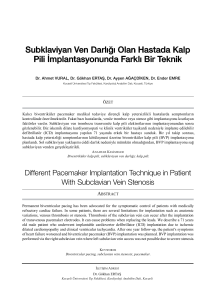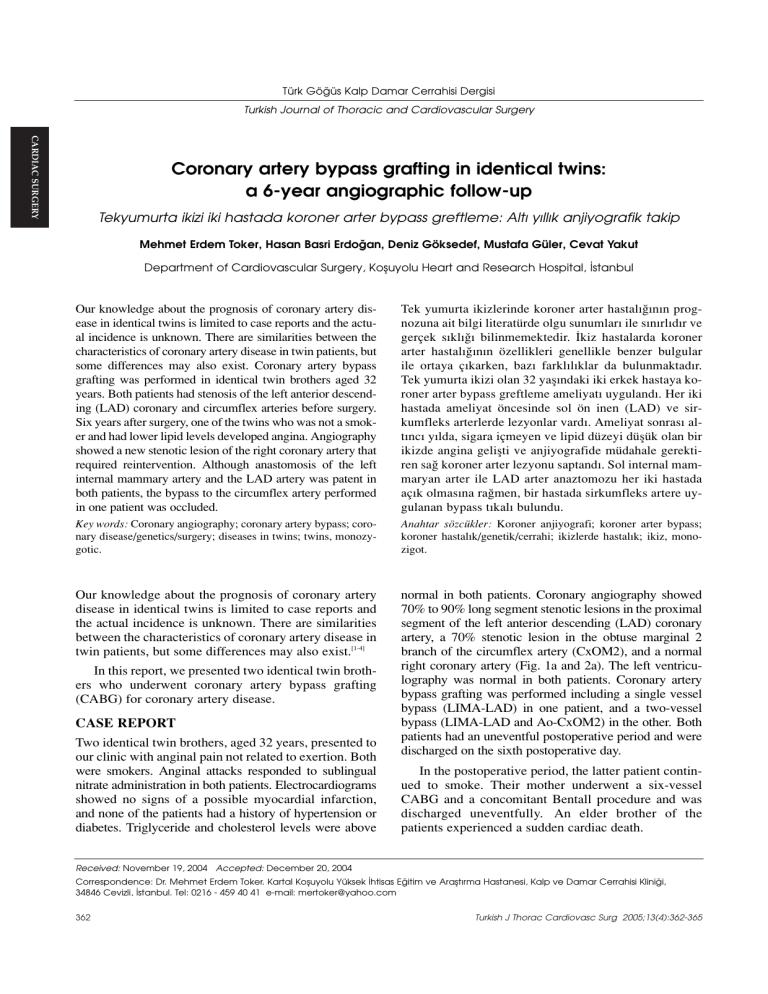
Türk Gö¤üs Kalp Damar Cerrahisi Dergisi
Turkish Journal of Thoracic and Cardiovascular Surgery
CARDIAC SURGERY
Coronary artery bypass grafting in identical twins:
a 6-year angiographic follow-up
Tekyumurta ikizi iki hastada koroner arter bypass greftleme: Alt› y›ll›k anjiyografik takip
Mehmet Erdem Toker, Hasan Basri Erdo¤an, Deniz Göksedef, Mustafa Güler, Cevat Yakut
Department of Cardiovascular Surgery, Kofluyolu Heart and Research Hospital, ‹stanbul
Our knowledge about the prognosis of coronary artery disease in identical twins is limited to case reports and the actual incidence is unknown. There are similarities between the
characteristics of coronary artery disease in twin patients, but
some differences may also exist. Coronary artery bypass
grafting was performed in identical twin brothers aged 32
years. Both patients had stenosis of the left anterior descending (LAD) coronary and circumflex arteries before surgery.
Six years after surgery, one of the twins who was not a smoker and had lower lipid levels developed angina. Angiography
showed a new stenotic lesion of the right coronary artery that
required reintervention. Although anastomosis of the left
internal mammary artery and the LAD artery was patent in
both patients, the bypass to the circumflex artery performed
in one patient was occluded.
Tek yumurta ikizlerinde koroner arter hastal›¤›n›n prognozuna ait bilgi literatürde olgu sunumlar› ile s›n›rl›d›r ve
gerçek s›kl›¤› bilinmemektedir. ‹kiz hastalarda koroner
arter hastal›¤›n›n özellikleri genellikle benzer bulgular
ile ortaya ç›karken, baz› farkl›l›klar da bulunmaktad›r.
Tek yumurta ikizi olan 32 yafl›ndaki iki erkek hastaya koroner arter bypass greftleme ameliyat› uyguland›. Her iki
hastada ameliyat öncesinde sol ön inen (LAD) ve sirkumfleks arterlerde lezyonlar vard›. Ameliyat sonras› alt›nc› y›lda, sigara içmeyen ve lipid düzeyi düflük olan bir
ikizde angina geliflti ve anjiyografide müdahale gerektiren sa¤ koroner arter lezyonu saptand›. Sol internal mammaryan arter ile LAD arter anaztomozu her iki hastada
aç›k olmas›na ra¤men, bir hastada sirkumfleks artere uygulanan bypass t›kal› bulundu.
Key words: Coronary angiography; coronary artery bypass; coronary disease/genetics/surgery; diseases in twins; twins, monozygotic.
Anahtar sözcükler: Koroner anjiyografi; koroner arter bypass;
koroner hastal›k/genetik/cerrahi; ikizlerde hastal›k; ikiz, monozigot.
Our knowledge about the prognosis of coronary artery
disease in identical twins is limited to case reports and
the actual incidence is unknown. There are similarities
between the characteristics of coronary artery disease in
twin patients, but some differences may also exist.[1-4]
normal in both patients. Coronary angiography showed
70% to 90% long segment stenotic lesions in the proximal
segment of the left anterior descending (LAD) coronary
artery, a 70% stenotic lesion in the obtuse marginal 2
branch of the circumflex artery (CxOM2), and a normal
right coronary artery (Fig. 1a and 2a). The left ventriculography was normal in both patients. Coronary artery
bypass grafting was performed including a single vessel
bypass (LIMA-LAD) in one patient, and a two-vessel
bypass (LIMA-LAD and Ao-CxOM2) in the other. Both
patients had an uneventful postoperative period and were
discharged on the sixth postoperative day.
In this report, we presented two identical twin brothers who underwent coronary artery bypass grafting
(CABG) for coronary artery disease.
CASE REPORT
Two identical twin brothers, aged 32 years, presented to
our clinic with anginal pain not related to exertion. Both
were smokers. Anginal attacks responded to sublingual
nitrate administration in both patients. Electrocardiograms
showed no signs of a possible myocardial infarction,
and none of the patients had a history of hypertension or
diabetes. Triglyceride and cholesterol levels were above
In the postoperative period, the latter patient continued to smoke. Their mother underwent a six-vessel
CABG and a concomitant Bentall procedure and was
discharged uneventfully. An elder brother of the
patients experienced a sudden cardiac death.
Received: November 19, 2004 Accepted: December 20, 2004
Correspondence: Dr. Mehmet Erdem Toker. Kartal Kofluyolu Yüksek ‹htisas E¤itim ve Araflt›rma Hastanesi, Kalp ve Damar Cerrahisi Klini¤i,
34846 Cevizli, ‹stanbul. Tel: 0216 - 459 40 41 e-mail: [email protected]
362
Turkish J Thorac Cardiovasc Surg 2005;13(4):362-365
One twin brother who had given up smoking after
surgery began to experience anginal pain in the postoperative sixth year. Coronary angiography showed a 70%
stenotic lesion in the distal end of the LIMA-LAD anastomosis and a 70% stenotic lesion in the proximal portion
of the right coronary artery (Fig. 1b). Coronary artery
stenting was performed in the right coronary artery. His
ventriculogram was normal. Coronary angiography of the
other twin, who was a smoker, showed a patent LIMALAD anastomosis, a totally occluded saphenous graft to
the CxOM2, and a normal right coronary artery (Fig. 2b).
His left ventriculogram was normal.
Lipid levels were above normal in both patients.
Interestingly, it was found that both the development of
anginal pain and progression of coronary atherosclerosis were seen in the one who was not smoking.
DISCUSSION
The similarities between the twin brothers with
regard to risk factors, the presentation of anginal
complaints, coronary anatomy, and coronary lesions
are worth mentioning. Sidd et al.,[5] who were the first
to point to this fact, showed similarities between
anginal complaints and lesions detected during coronary angiography. In our patients, similarities and differences existed between the lesions of the LAD and
Cx arteries and their localizations, and between the
anatomies of the Cx arteries.
(a)
(b)
Fig. 1. (a) Preoperative and (b) postoperative angiographic views of one twin brother who developed anginal pain in the postoperative sixth year. A new lesion occurred after LIMA-LAD anastomosis and a %70
lesion in the proximal portion of the right coronary artery.
Türk Gö¤üs Kalp Damar Cer Derg 2005;13(4):362-365
363
KALP CERRAH‹S‹
Toker ve ark. Tekyumurta ikizi iki hastada koroner arter bypass greftleme: Alt› y›ll›k anjiyografik takip
Toker et al. Coronary artery bypass grafting in identical twins: a 6-year angiographic follow-up
CARDIAC SURGERY
Holmes et al[6] also found anatomical and pathological
similarities and differences during angiography of twin
patients. An interesting feature of the twins presented is
that their mother underwent CABG with a concomitant
Bentall operation and their elder brother died because of
sudden cardiac death two years after the twins’ operation,
both of whom had increased total cholesterol levels. A
family history of sudden cardiac death is a very important
feature in both male and female patients.[7] This increased
risk is at least partially related with genetic factors.
Both of the twin patients had high blood cholesterol
levels and one patient continued smoking after CABG.
Both were under statin treatment. Although the non-
smoker twin had lower lipid and cholesterol levels, he
was the one that started to describe anginal attacks.
When the environmental factors that affect total cholesterol and apolipoprotein B levels are considered, a
positive correlation was found in the twins who shared
the same environment compared to those who did not.[8]
The twins presented had been living in the same environment.
Differences were found in the pathology of coronary
artery disease in the twins who underwent operation on
the same day. These differences became most obvious
in the sixth postoperative year. In spite of the fact that
they were living in the same environment, the twin who
(a)
(b)
Fig. 2. (a) Preoperative and (b) postoperative angiographic views of one twin brother who continued smoking
after surgery. There is no lesion after LIMA-LAD anastomosis. Despite formation of a plaque, lesions in the right
coronary artery are not critical.
364
Turkish J Thorac Cardiovasc Surg 2005;13(4):362-365
gave up smoking and had a lower cholesterol level
showed a faster progression of atherosclerosis. This
shows that not only the risks and environmental factors
play a role in the progression of the disease but also
genetic factors are important.
REFERENCES
1. Herrington DM, Pearson TA. Clinical and angiographic similarities in twins with coronary artery disease. Am J Cardiol
1987;59:366-7.
2. Samuels LE, Samuels FS, Thomas MP, Morris RJ, Wechsler
AS. Coronary artery disease in identical twins. Ann Thorac
Surg 1999;68:594-600.
3. Kaluza G, Abukhalil JM, Raizner AE. Identical atheroscle-
Türk Gö¤üs Kalp Damar Cer Derg 2005;13(4):362-365
rotic lesions in identical twins. Circulation 2000;101:E63-4.
4. Ener S. Coronary artery disease in identical twins. Ann
Thorac Surg 2000;70:692.
5. Sidd JJ, Sasahara AA, Littmann D. Coronary-artery disease
in identical twins. A family study. N Engl J Med 1966;274:
55-60.
6. Holmes DR Jr, Kennel AJ, Smith HC, Gordon H, Moore SB.
Coronary artery disease in twins. Br Heart J 1981;45:193-7.
7. Marenberg ME, Risch N, Berkman LF, Floderus B, de
Faire U. Genetic susceptibility to death from coronary
heart disease in a study of twins. N Engl J Med 1994;330:
1041-6.
8. Heller DA, de Faire U, Pedersen NL, Dahlen G, McClearn
GE. Genetic and environmental influences on serum lipid
levels in twins. N Engl J Med 1993;328:1150-6.
365
KALP CERRAH‹S‹
Toker ve ark. Tekyumurta ikizi iki hastada koroner arter bypass greftleme: Alt› y›ll›k anjiyografik takip

